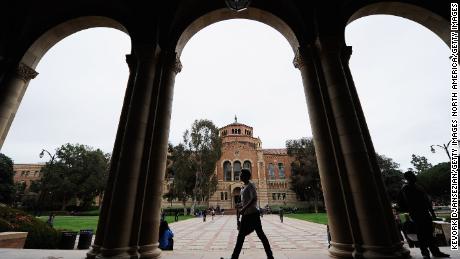Nearly two decades ago, I was barely scraping by at community college, only able to afford it thanks to Pell Grants and my job as a server.
Neither of my parents had graduated from college, and I had been rejected from my dream school, the University of Texas at Austin. It had taken me until 21 to even enroll in community college because of the cost.
Eventually I was able to transfer to UT-Austin and now I’m the executive director of the nation’s largest young voter turnout organization, a former US Senate candidate, and a published author.
Austin Community College was filled with all kinds of people, from teenagers to young parents to people restarting careers in midlife. Many, like me, were the first in their family to pursue a higher education.
A society’s greatest asset is its people, and for decades, America invested in its people by offering free education from kindergarten through 12th grade. While that is still the case, a bachelor’s degree is today’s equivalent of what a high school diploma once represented on the job market. In many industries, it’s the bare minimum requirement to get your foot in the door.
Unfortunately, the cost of tuition at a public, four-year institution has more than doubled over the last 20 years, vastly outpacing the rate of inflation. The tuition spike at community colleges is very similar. If I was starting all over again, I might not have been able to afford it.
Too often Americans who start college drop out before graduating. A whopping 56% of students who take on debt at public colleges, universities, or community leave before receiving their degree, according to an analysis by OneClass. The situation has been exacerbated by the pandemic. As unemployment increased and industries shuttered, many found themselves struggling to cover tuition fees.
Fortunately, Democrats have introduced plans that would break down the barriers so many Americans face when it comes to higher education.
President Joe Biden’s American Families Plan would guarantee free community college while lowering the cost for low-income and middle-income students at Historically Black Colleges and Universities, Tribal Colleges and Universities, and Minority Serving Institutions. Low-income students would further benefit from an increase in the maximum Pell Grant award by approximately $1,400, and DREAMers would be able to access Pell Grant funding for the first time
Making the plan even more invaluable to me, the working mother of a 4-year-old, is its promise of free pre-kindergarten for two years. Millions of other American parents, like the many I befriended at Austin Community College, would benefit.
In Congress, the College for All Act, introduced by Vermont Sen. Bernie Sanders and Washington Rep. Pramila Jayapal, would go even further, making all four-year public colleges and universities tuition-free for families earning under $125,000. The act would also guarantee tuition-free education at nonprofit Historically Black Colleges and Universities, Tribal Colleges and Universities, and Minority Serving Institutions.
Tuition-free college would go a long way toward reducing racial inequities in higher education. For instance, Black student loan borrowers owe nearly twice as much as their White counterparts four years after graduation, research by the Brookings Institution demonstrates.
As the executive director of NextGen America, which focuses on turning out young voters, I know that the cost of college is a top concern of young people. Every day, we talk to young Americans with stories like mine, about being the first in their family to attend college or having to work one or more jobs to pay their way through.
Making higher education significantly more accessible would not only be life-changing for millions of Americans, but would build a workforce that is better prepared for the global challenges that lie ahead. We have a climate crisis to tackle, infrastructure to map and an economy to rebuild. Particularly after the pandemic sidelined so many young people from higher education, it is urgent to resolve our crisis of college affordability.
While advocates push for the enactment of the American Families Plan and the College for All Act, we must also keep in mind the Americans whose pursuit of higher education has already resulted in a crushing debt burden. With the flick of a pen, President Biden can cancel as much as $50,000 per borrower in student debt — a move that he has rejected so far.
By canceling student debt and providing tuition-free college, our leaders can open doors for generations of Americans to opportunities they may not have otherwise had. It would be a win for the United States — even more so as we are emerging from the pandemic.
America grew its middle class by investing in public education and rebuilding the middle class should not be a partisan issue. We can ensure the long-term health and success of our nation by recommitting to that investment.

